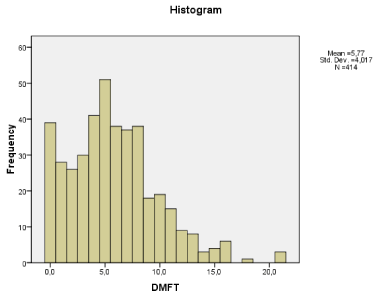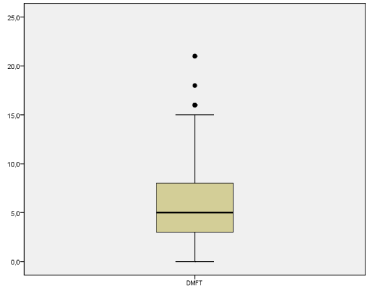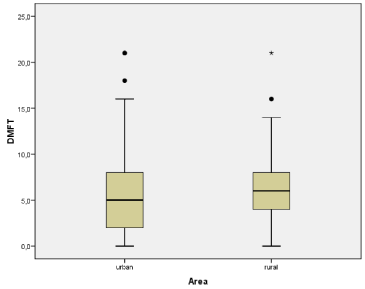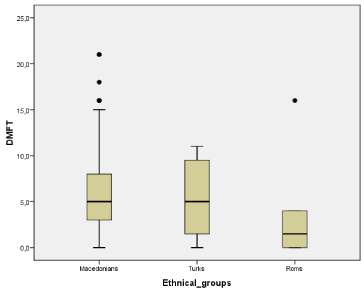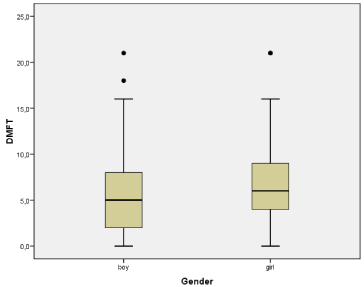
Research Article
J Dent App. 2014;1(4): 68-74.
Experience and Prevalence of Dental Caries Among 15-year Old Adolescentsin the Eastern Region of the Republic of Macedonia
Vesna Ambarkova1*, Valentina Spasova2 and Raffaella Matteucci Gothe3
1MSc, DDS, University St. Cyril and Methodius, Faculty ofDental Medicine, Department of Paediatric andPreventive Dentistry, Skopje, Republic of Macedonia
2PHO Health Center Dr. Pance Karagozov, Sector for preventive and pediatric dentistry str: HristijanKarpoš bb, 2000Štip, Austria
3Institute of Public Health, Medical Decision Making and HTA, street: Eduard-Wallnöfer-Zentrum 1, 6060, Hall in Tirol, Austria
*Corresponding author: Vesna Ambarkova PhD., Candidate. MSc, DDS, University St. Cyril and Methodius, Faculty of Dental Medicine, Department of Paediatric andPreventive Dentistry, Vodnjanska 17 University Dental Clinic Center Sv. Pantelejmon, Skopje 1000 , Republic of Macedonia
Received: July 02, 2014; Accepted: September 16, 2014; Published: September 18, 2014
Abstract
Aim: The aim of this study was to investigate the experience and prevalence of dental caries among secondary school adolescents (first grades) in Eastern Region of the Republic of Macedonia.
Methods: In this cross-sectional study, adolescents from8 Secondary Schools (first grades, N= 414) were selected. Participants dental status was evaluated using the 2013 World Health Organization caries diagnostic criteria for Decayed, Missing or Filled Teeth (DMFT) by 2 calibrated examiners.
Results: The total number of adolescents the sample was 414, comprising 188 (45.4%) females and 226 (54.6%) males. The mean DMFT was 5.77, with standard deviation (SD) of 4.02 and 95% confidence interval (CI) of 5.38- 6.16. Significant caries (SiC) index was 10.22.The prevalence of caries-free adolescentswas9.4%. The percentage of untreated caries or the ration of D/ DMFT was 0.49 (49.05%). The prevalence of dental caries in secondary school adolescents was 90.6%.
Conclusions: Dental caries experience was seen to be high among 15- year old secondary school adolescents(first grades) in Eastern Region of the Republic of Macedonia.
Keywords: Caries; Caries prevalence; DMFT index; Macedonia
Introduction
Dental caries is a public oral health problem and one of the major unmetneeds in oral health amongst the teenage population of the Republic of Macedonia, It is an infectious-contagious disease implying an imbalance of normal molecular interactions between the teeth's surface/subsurface and the adjacent microbial biofilm [1]. It becomesexpressed during a certain period of time as an accumulative demineralizationwhich, if not treated, has the potential for producing cavities in the enamel andcollateral damage in dentine and pulpar tissues [2].
It is widely recognized that adolescents are among theleast likely to use the health services [3] and some studies have shown that dental care is the most common typeof unmet health care need in adolescence [4,5]. It is therefore worrying that adolescents reduce their utilization ofdental services [6], and may altogether cease to attend thedentist upon leaving school [7]. Adolescents may be at greater risk for dental disease during a developmental periodswhen they are establishing oral care habits [8]. Based on the information from the Ministry of Education and Science there are 91.167 students attending 113 secondary schools in the Republic of Macedonia. Number of students at first grade of secondary schools are 20.017, in the whole country.
The results for the state of oral health and rehabilitation needs of our Macedonian population obtained from epidemiological study in 1990, worked as part of a joint Yugoslav study "Assessment of oral health and treatment needs of the population of Yugoslavia by applying the basic criteria of the WHO initiative" indicate a very serious condition. DMFT scores were in range from 0.54 in six-year children to 23.84 in the population of 65 years [9].
The high level of caries prevalence in 15 years old in the Republic of Macedonia was recorded in 1991 (DMFT 8.13) by Neceva et al. [10]. At the same time dentistry in Macedonia had its rapid development as well in manpower and equipment, but strictly oriented toward therapeutic dentistry. This argument and such high DMFT gave the initiative idea for creating a National Strategy for prevention of oral diseases in child population of Macedonia in 2007 [11].
Children from this age group were born in 1997/98 and were not exposed to fissure sealing of the first permanent molars right after their eruption, which was part of the National Caries Preventive Program and National Strategy and started to be implemented in 2007 [11].
In the future we expect as a result of the application and implementation of the National Strategy for prevention of oral diseases in children from 0 to 14 years of age, launched in 2007, DMFT index in this group of children drastically to be reduced.
The aim of this study was to investigate the experience and prevalence of dental caries among secondary school adolescentswithin the Eastern Region of the Republic of Macedonia and evaluate how their disease pattern is related to variables, such as gender, rural-urban areas of the population.
Methods
Statistical data that was collected were from 15-year-old secondary schooladolescents children in the Eastern part of the Republic of Macedonia. For each child following data was recorded: age, sex (male or female), ethnic group, area (urban or rural), city/ village, number of decayed teeth (DT), number of missing teeth (MT) and number of filled teeth (FT). Then, the DMFT score, the sum of DT, MT and FT, was calculated and recorded for each child. The size of the statistical sample was 414.
The sample for the present cross-sectional study was 414 secondary school children from first grades, attending secondarymunicipality schools and gymnasiums in the cities from this region (Gymnasium Koco Racin and secondary municipality school" Koco Racin"(auto mechanics and mechatronicians) from Sveti Nikole. secondary schools Gošo Vikentiev and Ljubco Santov from Kocani, secondary school Metodi Mitevski Brico from Delcevo and secondary municipality school Nikola Nehtenin, secondary textile school Dimitar Mirasciev and high musical school Sergej Mihajlov secondary music school from Štip. Based on the information from the Macedonian Institute of Statistic [12] there are approximately 7172 students attending 13 secondary schools in this region. From 505 secondary school students in Delcevo, 131 are at first grade, while in Kocani from 2.745 students in total from secondary schools in Kocani 446 are at first grade.
The research was carried out within 2012 and 2013, and included 414 secondary school pupils of both sex at the age of 15 in the eastern area of the Republic of Macedonia. The parameters used to estimate oral health condition were mean number of decayed, missing and filled teeth due to caries (DMFT), Significant Caries Index (SiC). Caries status was registered by Klein-Palmer system DMF(D-Decayed, M-Missing, F-Filled).A dental team clinically examined all the subjects in line with World Health Organization (WHO) methodology and criteria [13]. Two examiners were trained and standardized using a Kappa test (>0.90) before starting the study. All data were expressed as mean ± standard deviation for continuous variables; frequencies and percentages were calculated for categorical data.
All the chosen children from the sample were checked by the standard dental diagnostic equipment (plane dental mirror, dental standard probe) under the artificial light on the dry teeth, on the dental chair. It was decided to use cluster sampling because it was more economical and achievable withinthe constraints of resources and finance.
Permission for the study was obtained from the school authorities, who sought and obtained consent from the parents of the children concerned.Ethical approval was obtained from the Ministry of Health.
A new index called the 'Significant Caries Index' (SiC)was recently proposed by the World Health Organization (WHO) to draw attention to thoseindividuals with the highest caries scores in each population [14]. The SiC Index leads tosignificant gains for society and for the persons concerned as more specific targetedpreventive actions can be implemented. The SiC is the mean DMFT of one third of the studygroup with the highest caries score.
Statistical Analysis
Statistical analysis was accomplished by using non-parametric Mann-Whitney U Test to see if there are differences in mean DMFT scores between sexand area groups. Kruskal-Wallis Test was performed to see if there are differences in mean DMFT scores between the cities group. Descriptive statistic was performed by calculating median and interquartile range. A standard statistical package SPSS Statistics 20 was used for performing the data analysis.
Results
In Table 1 and 2, the distribution of individuals in studied sample is given.
Sex
AreaMale
Female
Total
Urban
146
121
267 (64,49%)
Rural
80
67
147 (35,51%)
Total
226 (54,6%)
188 (45,4%)
414
Table 1: Distribution of individuals in studied sample (gender, area)..
ethnic
affiliation
City/Villageof living
Macedonians
Turks
Roms
Total
Delcevo
76
3
2
81(19.57 %)
Kocani
70
0
1
71 (17.15%)
Sveti Nikole
56
1
1
58 (14.01%)
Štip
50
1
4
55 (13.29 %)
Obleševo
14
0
0
14
Trkanje
10
0
0
10 (2.42 %)
Zvegor
7
0
0
7 (1.69 %)
Spancevo
7
0
0
7 (1.69 %)
Zrnovci
7
0
0
7 (1.69 %)
Ciflik(surrounding of Kocani)
6
0
0
6 (1.45 %)
Sokolarci
6
0
0
6 (1.45 %)
Grad
5
0
0
5 (1.21 %)
Stamer
5
0
0
5 (1.21 %)
GorniPodlog
5
0
0
5 (1.21 %)
Erdjelija
4
0
0
4 (0.97 %)
Probištip
3
0
0
3 (0.72 %)
Star Karaorman
3
0
0
3 (0.72 %)
Karbinci
3
0
0
3 (0.72 %)
Trabotivište
3
1
0
4 (0.97 %)
Virce
3
0
0
3 (0.72 %)
Mojanci
3
0
0
3 (0.72 %)
Sasa
3
0
0
3 (0.72 %)
Selce
0
2
0
2 (0.48 %)
Others
49
0
0
49(11.84%)
Total
398 (96.14 %)
8 (1.93 %)
8 (1.93 %)
414( 100%)
Table 2: Distribution of individuals in studied sample (city/village of living ,ethnic affiliation).
The mean value of the DMFT index for the whole sample is 5.77, with standard deviation (SD) of 4.02, and 95% confidence interval (CI) of 5.38-6.16. In the whole sample, 9.4% of the individuals were caries free (DMFT=0). As a complement of the mean DMFT value, for the whole sample, the SiC index of 10.22 was calculated.
In Figure 3, the distribution of DMFT score is given. In Figure 4, the boxplot of DMFT score in the whole sample is given, showing the range, quartiles and outliers. The mean DMFT index with SD and 95% CI were calculated for each group (according to gender, area of living, age, nationality, city or village) and these results are reported in Table 3. In this study were included 46 adolescents aged 14, 334 adolescents aged 15, 32 adolescents aged 16 and only 2 adolescents aged 17. The sample consisted only three ethnic groups (Macedonians, Roms and Turks),since only Macedonians ethnic group count more than 30 individuals (Table 2), the ethnic groups were not statistically analyzed. Among the groups formed by city or village of living, only four of them count more than 30 individuals (Table 2), they are groups from Štip, Kocani, Delcevo and Sveti Nikole, so only for these groups the statistical analysis was performed. In Table 3, the percentage of caries free individuals for each group is also reported. Distributions of DMFT scores for some of the groups are illustrated by the boxplots (Figures 3, 4 and 5).
Figure 1: Distribution of DMFT score in the whole sample.
Figure 2: Boxplot of DMFT score in the whole sample.
Figure 3: Boxplots of DMFT score for area groups.
Figure 4: Boxplots of DMFT score for ethnical groups.
Figure 5: Boxplots of DMFT score for gender.
caries free
DMFT
p-value
Mean (SD)
95% CI
whole sample
39 (9.4 %)
5.77 (4.02)
5.38-6.16
sex groups
male
27 (6.52%)
5.04 (3.77)
4.54-5.53
P<0.05
female
12 (2.89%)
6.65 (4.14)
6.05-7.25
area groups
urban area
28 (6.76%)
5.61 (4.20)
5.11-6.12
0.107
rural area
11 (2.66%)
6.048 (3.66)
5.45-6.64
age groups
14 years
6 (1.45%)
5.2 (3.5)
2.49-4.51
15 years
27 (6.52%)
5.9 (4.1)
3.66-4.54
16 years
6 (1.45%)
4.9 (4.1)
2.68-5.52
17 years
0 (0.00%)
3,0 (1.4)
-0.54-3.34
ethnic groups
Macedonians
34 (8.21%)
5.82 (3.98)
5.43-6.22
Turks
2 (0.48%)
5.38(4.41) 1.69-9.06
Roms
3 (0.72%)
3.38 (5.37)
-1.12-7.87
city/village
Štip
11 (2.66%)
3.38 (2.86)
2.11-3.62
P<0.05
Sveti Nikole
8 (1.93%)
4.81 (3.64)
2.70-4.58
Delcevo
2 (0.48%)
8.70 (4.69)
3.67-5.71
Kocani
7 (1.69%)
4.72 (3.08)
1.98-4.18
Table 3: Caries free individuals, DMFT scores and equality tests for mean DMFT index.
U-Mann-Whitney-Test was performed to see if there are differences in mean DMFT scores between sex groups, and corresponding p-value that is less than 0.05 was funded (p<0.05), which means that there are statistically significant difference between sex groups, is reported in Table 3. Kruskal-Wallis rank sum test is a non-parametric test, so the normality of data is not necessary, the equality of medians is tested, and it achieves its best performance for sample sizes 5 and larger. Kruskal-Wallis Test was performed to see if there are differences in mean DMFT scores between the cities group, and p-value that is less than 0.05 was funded (p<0.05), which means that there are statistically significant difference between cities. Mann-Whitney Test was performed to see if there are differences in mean DMFT scores between area groups, and p-value that is more than 0.05 was funded (p=0.107, p >0.05), which means that there is not statistically significant difference between mean DMFT scores in rural and urban area.
The DMFT components, DT, MT and FT, were also analyzed. Their frequencies, mean values, SD's and 95% CI's are reported in Table 4. It is important to describe the composition of the DMFT, which allows us to evaluate the level of dental care in the country.
Frequency
Mean (SD)
95% CI
DT
49.05%
2.83 (2.74)
2.48-3.01
MT
7.07%
0.19 (0.94)
0.85-1.03
FT
43.88%
2.53 (3.03)
2.73-3.32
Table 4: DT, MT, FT frequencies and scores for the whole sample.
Discussion
The present results revealed that the prevalence of caries in 15- year old adolescents living in the East region is 90.6%. The overall mean DMFT was 5.77(±4.02) and this can be classified as high dental caries experience. This view can be strongly supported by the finding that the caries-free prevalence was 9.4%.
Children in rural areas had more decayed teeth and fewer filled teeth than urban children, suggesting poorer dental services in villages.In our study the DMFT score of children from rural area was 6.05 (±3.66) in comparison with DMFT score of 5.61 (±4.20) in children from urban area, but statistical difference is not significant.
In our study there are statistically significant difference between sex groups. The mean DMFT for female was 6.65 (±4.14) and 5.04 (±3.77) for male.According to theliterature, being a girl is a strong predictor for severityof caries because they have an earlier tooth eruption [15].
Unlike our results, Nashkova et al. [16] examining DMFT score in children 12-15 years of age in Štip and its surroundings received values which was 6.20 for the children of the urban environment and 6.77 for children from rural areas, where the differences between the two values studied groups were statistically significant (p <0.01).
Our results are much worse than those made in Slovenia, which until 1991 was an integral part of SFRJ. In 1998 there was a decline in the prevalence of caries in the group of 15 and 18-year-old children and DMFT score is reduced from 10.2 (in 1987) to 4.3 in 15-year-old children and from 12.9 to 7.0 in 18-year-old children.The analysis of this epidemiological study suggests that the reason for this drastic reduction of DMFT score was due to the implementation of preventive programs with strict tooth brushing, fluoride prophylaxis with gels for washing and preventive sealing of fissures [17].
However, according to the results given by Ambarkova et al. [18] in 2013, mean DMFT (3.47) value was acquired in the 12-year children from East region of our country. Because we know that DMFT score increases with increasing age, we expected that the15-year group of children from East region will have higher DMFT scores than 12-year old children.
Decayed, missing and filled teeth constituted 49.05%, 7.07% and 43.88%, respectively, in the DMFT index structure. Maybe such a high DMFT score of 5.77 with standard deviation (SD) of 4.02 was due to a significant decrease in number of pediatric dentists and school dental offices in last decade in the Republic of Macedonia.
The results of this study indicate very poor oral health enterprises which are due to improperly organized dental service, dental staff inadequately deployed, unplanned work and most importantly the absence of an organized and planned preventative activity that existed in the past.
Our results are worse than those obtained in Iraq byHamissi Jet al in 2008.In the Hamissi J study, of the total sample, only 24.5% were caries free, i.e., the caries prevalence was 75.5%. The mean DMFT value for the total sample was 2.71 (+/- 0.86). Male students had a higher mean DMFT value (2.88 +/- 0.61) than female students (2.54 +/- 0.71) (P > 0.05). The mean DMFT value for the 15-year-old children was 2.66 (+/- 0.85) and for the 16-year-old children it was 2.76 (+/- 0.92). No statistically significant difference was found between male and female students [19].
During the last decades, a decrease in world prevalence of caries has been observed. Marthaler (2003) presents the decrease in caries indexes in several European countries in different ages and age groups [20]. In the study of Gorbatova AM et al., conducted in north-west Russia, the prevalence of caries was 91.8% with a mean DMFT of 4.92. In her study no gender differences in the prevalence ofcaries in any of the settings or in the full sample were observed.Also in her study, in urban areas, the average number ofdecayed teeth was lower (2.15 vs. 2.95, p=0.006), while the number of filled teeth was greater (2.71 vs.1.79, p<0.001) than in rural areas [21].
In the present study, decay contributed the most to the DMFT for 15 year-old adolescents, indicated that untreated caries was a problem for this age group. The decayed component (D= 49.05%) constituted the main part of the DMFT score. Also, FT (F=43.88%), were the major part of DMFT in adolescents from this study.
In many studies, variables such as age [22-25] and sex [16,18] played a substantial role in cariesexperience.
The main advantage of this study is that it, like previous study conducted by Neceva et al. [10], was performed using internationally accepted methodology recommended by the WHO (1997) [13], allowing comparability of the findings with European studies and with earlier studies in the region. The limitations of the DMFT index for epidemiological use have been discussed in many articles [26- 29]. It is claimed that it mixes disease and treatment and makes it difficult to differentiate between previous or existing caries. The index is irreversible and cannot inform whether restorations (filled teeth F), are due to caries or other reasons, e.g. hypoplasia. The "filled teeth (F)" criterion is also inaccurate as the criteria behind the decision of a practitioner to fill a tooth, are undefined. Another problem is that the DMFT index does not indicate whether the caries lesion reported is in an active or inactive state (arrested caries). It is additionally impossible to consider the number of teeth that are at risk of caries and it cannot monitor caries progression. Another limitation is that we did not use the ICDAS system which gives more detailed description on the severity of caries.
Small sample size, however, is the main limitationof the study. It resulted in low statistical power for comparisons of caries prevalence and experience between ethnic groups and city/village locations. Given thatthe sample was taken from all partsof the region, we consider our results generalizableto the whole Eastern region of our country.
According to Krisdapong S et al. [30], the traditional method of measuring oral health and treatment needs, based principally on clinical indices, is inadequate [31]. He tough that to better comprehend a population's oral health and consequently plan oral health services more appropriately, some countries have included measures of perceived oral health or OHRQoL in their national oral health surveys [32-36]. It's worth to notice that National data on OHRQoL (Oral Health Related Quality of Live) of children and adolescents are not easily available.
The statistically significant difference of the caries experience between the cities and villages might be explained by the different fluoride concentration in drinking water. In the previous study we found that the concentration of fluorine in the tap water in Štip was 0.75 ppm F, in ??c?ni 0.45 ppmF, in Sveti Nikole 0.26 ppmF and the lowest concentration of fluorine we found in Delcevo city (0.31 ppmF) [37,38]. In Delcevo we found low concentrations of fluoride in drinking water, we obtained the highest values for DMFT score, while in Sveti Nikole and Kocani cities DMFT scores in 15-year olds is almost the same.
Conclusion
According to the findings of the present study, the conclusions are:
The prevalence of dental caries in secondary school adolescents from First Grades from the Eastern Region of the Republic of Macedonia was 90.6% and variedbetween the cities from 97.34% in Štip, 98.07% in Sveti Nikole, 98.31% in Kocani and 99.52% in Delcevo.
The mean DMFT was 6.05 (±3.66) and varied between cities from 3.38 (±2.86) in Štip, 4.72 (±3.08) in Kocani, 4.81 (±3.64) in Sveti Nikole to 8.70 (±4.69) in Delcevo. Significant gender and city/villages,but not urban/ rural, variations in caries experiencewere observed.Urgent public healthmeasures on both population and individuallevels are needed to improve the situation.
Acknowledgements
The authors also thank to the teachers and children of all primary schools from the two municipalities Pechcevo and Berovo in the Eastern region, for their willing assistance and cooperation which made this study possible.
Funding
No external funding was available for this study.
Statement of conflict of interest
In the opinion of the authors, there is no conflict of interests.
References
- García-Cortés OJ, Medina-Solís CE, Loyola-Rodriguez JP, Mejía-Cruz JA, Medina-Cerda E, et al. Dental caries' experience, prevalence andseverity in Mexican adolescentsand young adults. Rev Salud Publica (Bogota). 2009; 11: 82-91.
- Pitts NB, Stamm JW. International Consensus Workshop on Caries Clinical Trials (ICW-CCT) - Finalconsensus statements: Agreeing where the evidence leads. J Dent Res. 2004; 83: C125-C128.
- Ryan SA, Millstein SG, Greene B, Irwin CE. Utilization of ambulatory health services by urban adolescents. J Adolesc Health. 1996; 18: 192-202.
- Newacheck PW, Brindis CD, Cart CU, Marchi K. Inwin CE. Adolescent health insurance coverage: recent changes and access to care. Pediatrics. 1999; 104: 195-202.
- McBroome K, Damiano PC, Willard JC. Impact of the Iowa S-SCHIP program on access to dental care for adolescents. Pediatr Dent. 2005; 27: 47-53.
- Hawley GM, Davies RM. Documented dental attendance patterns during childhood and adolescence. Br Dent J. 1996; 180: 145-148.
- Lopez V, Bealum V. Factors associated with dental attendance among adolescents in Santiago, Chile. BMC Oral Health. 2007; 7: 4.
- Coolidge T, Heima M, Johnson EK, Weinstein P. The Dental Neglect Scale in adolescents. BMC Oral Health. 2009; 9: 2.
- Rajic Z, Stošic P. "Assessment of oral health and treatment needs of the population of Yugoslavia by applying the basic criteria of the WHO initiative", Research projects, 1990.
- Neceva et al. Oral Health Condition in population from SR Macedonia and Required treatmentaccording to World Health Organization Criteria. Skopje, March 1991. The project wasfinancial supported by the Republic Scientific Researches Organization.
- Sarakinova O, Carcev M, Getova B, Carceva Salja S, Janevska S. National strategy for prevention of oral diseases in children from 0 to 14 years of age in the Republic of Macedonia for the period from 2008 to 2018. Prilozi. 2013; 34: 129-135.
- Primary, Lower Secondary and Upper Secondary Schools at the end of the school year 2011/2012. Statistical Review: Population and Social Statistics.
- World Health Organization. Oral health surveys, basics methods. 5. ed. Geneve, 2013.
- Bratthall D. Introducing the Signifi cant Caries Index together with a proposal for a new global oral health goal for 12-years-old. Int Dent J. 2000; 50: 378-384.
- Parner ET1, Heidmann JM, Vaeth M, Poulsen S. A longitudinal study of time trends in the eruption of permanent teeth in Danish children. Arch Oral Biol. 2001; 46: 425-431.
- Naškova S. Caries risk factors and state of oral and dental health in Štip and its surrounding.Master thesis. Faculty of Dentistry, University of St. Cyril and Methodius. 2011 Skopje.
- Vrbic V. Reasons for the caries decline in Slovenia. Community Dent Oral Epidemiol. 2000; 28: 126-132.
- Ambarkova V, Ivanova V. Dental Caries Experience among primary school children in the Eastern Region of theRepublic of Macedonia. Oral Health & Dental Management OHDM. 2014; 13: 514-520.
- Hamissi J, Ramezani GH, Ghodousi A. Prevalence of dental caries among high school attendees in Qazvin, Iran. J Indian Soc Pedod Prev Dent. 2008; 26 Suppl 2: S53-S55.
- Marthaler TM. Changes in dental caries 1953-2003. Caries Res. 2004; 38: 173-181.
- Gorbatova AM, Gorbatova LN, Grjibovski AM. Dental caries experience among 15-year-oldadolescents in north-west Russia. Int J Circumpolar Health. 2011; 70: 232-235.
- Casanova-Rosado AJ, Medina-Solís CE, Casanova-Rosado JF, Vallejos-Sánchez AA, Maupomé G, et al. Dental caries and associated factor in Mexican schoolchildren aged 6-13 years. Acta Odontol Scand. 2005; 63: 245-251.
- Medina-Solis CE, Maupomé G, Pelcastre- Villafuerte B, Avila-Burgos L, Vallejos-Sánchez AA, et al. Socioeconomic inequalities in oral health: dental Caries in 6 to 12-year-old children. Rev Invest Clin. 2006; 58: 296-304.
- Solorzano I, Salas MT, Chavarria P, Beltran-Aguilar E, Horowitz H. Prevalence and severity of dental caries in Costa Rican schoolchildren: results of the 1999 national survey. Int Dent J. 2005; 55: 24-30.
- Archila L, Bartizek RD, Gerlach RW, Jacobs SA, Biesbrock AR. Dental caries in school-age children residing in five Guatemalan communities. J Clin Dent. 2003; 14: 53-58.
- Klein H, Palmer C, Knutson J. Studies on dental caries: I. Dental status and dental need of elementary school children. Pub Health Rep. 1938; 53: 751-765.
- Whelton H, O'Mullane D. Public Health Aspects of Oral Diseases and Disorders- Dental Caries. In Community Oral Health. 2ndth edition. Edited by Pine CM, Harris RV. London: Quintessence Publishing Co. Ltd; 2007: 115-253.
- Pitts NB, Wefel JS. Remineraliztion/desensitization: what is know? What is the future? Adv Dent Res. 2009; 21: 83-86.
- Burt B, Eklund SA. Measuring Dental Caries. In Dentistry, Dental Practice and the Community. 5th edition. Edited by Burt B, Eklund SA. Philadelphia: W.B. Saunders Company; 1999: 178-181.
- Krisdapong S, Sheiham A, Tsakos G. Oral health-related quality of life of 12- and 15-year-old Thai children: findings from a national survey. Community Dent Oral Epidemiol. 2009; 37: 509-517.
- Locker D. Measuring oral health: a conceptualframework. Community Dent Health. 1988; 5: 3-18.
- Kelly M, Steele J, Nuttall N, Bradnock G, Morris J,Nunn J et al. Adult Dental Health Survey: Oralhealth in the United Kingdom 1998. London: TheStationery Office; 2000.
- Sanders AE, Slade GD, Lim S, Reisine ST. Impact oforal disease on quality of life in the US andAustralian populations. Community Dent Oral Epidemiol. 2009; 37: 171-181.
- John MT, Hujoel P, Miglioretti DL, Leresche L,Koepsell TD, et al. Dimensions of oralhealth-related quality of life. J Dent Res. 2004; 83: 956-960.
- Aromaa A, Koskinen S eds. Health and functionalcapacity in Finland. Baseline results of the Health2000 Health Examination Survey. Helsinki: KTLNational Public Health Institute; 2004; 62-66.
- Bae KH, KIM C, Paik DI, Kim JB. A comparison oforal health related quality of life between completeand partial removable denture-wearing older adultsin Korea. J Oral Rehabil. 2006; 3: 317-322.
- Ambarkova V, Topitsoglou V, Iljovska S, Carcev M. Natural fluoridated drinking water from the Republic of Macedonia. Macedonian Stomatological Review. 2005; 29: 177-182.
- Ambarkova V, Kalfas O, Topitsoglou V, Carcev M, Dimitrovska S, Arsova V, Andonova V. Naturally fluoridated drinking waters in the Republic of Macedonia. 9-th Congress of the Balkan Stomatological Society. Ohrid. 2004: 167.
